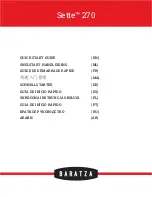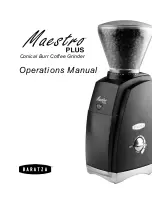
10
4. With the spindle facing the operator, rotate the guard clockwise into the desired
working position. The guard body should be positioned between the spindle and
the operator to provide maximum operator protection.
5. For easy adjustment, the guard can be rotated in the clockwise direction.
NOTE:
The guard release lever should snap into one of the alignment holes (K)
on the guard collar. This ensures that the guard is secure. The guard can be
repositioned in the opposite direction by depressing the guard release lever.
6. To remove the guard, follow steps 1–3 of these instructions in reverse.
FIG. 2
I
K
H
J
F
Fitting and Removing a Grinding Disc (Fig. 1, 3)
WARNING:
Do not use a damaged disc.
1. Place the tool on a table, guard up.
2. Fit the backing flange (D) correctly onto the spindle (B) (Fig. 3).
3. Place the disc (M) on the backing flange (D). When fitting a disc with a raised
centre, make sure that the raised centre (L) is facing the backing flange (D).
4. Screw the threaded clamp nut (E) onto the spindle (B) (Fig. 3):
The ring on the threaded clamp nut (E) must face towards the disc when fitting a
grinding disc.
5. Press the spindle lock button (A) and rotate the spindle (B) until it locks in
position.
6. Tighten the threaded clamp nut (E) with the hex
E
D
B
M
L
FIG. 3
key provided or a two pin spanner.
7. Release the spindle lock.
8. To remove the disc, loosen the threaded clamp
nut (E) with the hex key provided or a two pin
spanner.
NOTE:
Edge grinding can be performed with Type 27
wheels designed and specified for this purpose; 6
mm thick wheels are designed for surface grinding
while 3 mm wheels are designed for edge grinding.
Mounting Wire Brushes and Wire
Wheels
Wire cup brushes or wire wheels screw directly on
the grinder spindle without the use of flanges. Use
only wire brushes or wheels provided with an M10
threaded hub. A Type 27 guard is required when using wire brushes and wheels.
CAUTION:
Wear work gloves when handling wire brushes and wheels.
They can
become sharp.
CAUTION:
Wheel or brush must not touch guard when mounted or while in use.
Undetectable damage could occur to the accessory, causing wires to fragment from
accessory wheel or cup.
1. Thread the wheel on the spindle by hand.
2. Depress spindle lock button and use a wrench on the hub of the wire wheel or
brush to tighten the wheel.
3. To remove the wheel, reverse the above procedure.
NOTICE:
Failure to properly seat the wheel hub before turning the tool on
may result in damage to tool or wheel.
Fitting and Removing a Backing Pad/Sanding Sheet (Fig. 1)
1. Place the tool on a table or flat surface, with the guard facing up.
2. Remove the backing flange (D).
3. Place the rubber backing pad correctly onto the spindle (B).
4. Place the sanding sheet on the rubber backing pad.


































